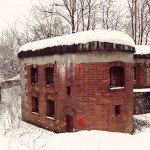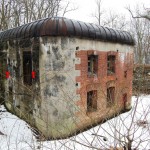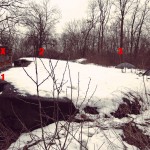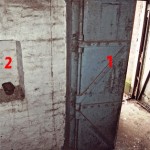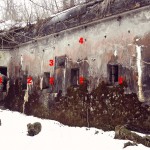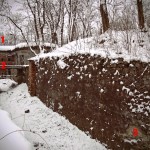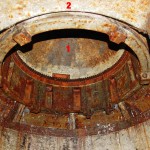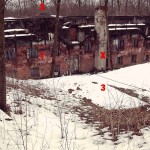Winnica (before July 1904 – GZW “53a Winnica”) was a detached fort of the outer fortress ring, situated on Vistula’s right bank in the south-western area of defence, called number VIII “Kobierzyn”. It was classifyed as intermediary fort for close defence.
The fort was built on top of the isolated hill Winnica – rising above the surrounding wetlands. Because of the limited available space the layout of the fort had to adjust to the specific environment. This resulted in a deep, storm-proof moat in the shape of a trapezoid. The access was possible only through the bridge spanning over the moat, additionally protected by the grates. In the corners of the moat there were a detached traditor /guardhouse building and a contrescarp caponier, while in the middle of the complex, a compact casemate building with armored turrets was situated. All structures had been constructed “bombproof” which ment in this case a layer of 2,0 m concred bades on steel beams (normally the standard thicknes of the concrete layer was 1,6m) .
Construction works began in September 1898 and the access road and back-up facilities were ready in December 1898. In spring 1899 the construction works resumed with the blasting of the ditch surrounding the fort, contrescarp caponier area and potern. In September 1899 the casemate building with its bomb-proof concrete flat roof were finished, so the gun turrets were deployed and assembled. The fort was considered as ‘warlike prepared’ on January 1st 1900. Despite that status the traditor guns were delivered but not assembled until the end of that year. Meanwhile the missing inner equipment and wire entanglements were added.
At the outbreak of WWI Winnica was fitted to combat readyness and a system of field fortifications was built on the south-western foreground. Interesting is the fact that the peace times guardhouse is still preserved today despite the fact that during the mobilization in 1914 it should have been demolished. Winnica was never involved in any combat activities during the war.
After the war it was assigned as storage facility to the polish army but never actually used. During the German occupation in the WWII the fort was used as a prison for Soviet POW. Since March 1989 the fort is listed in the Register of Historical Monuments (number A-800). The valuable armor equipment has been preserved – both artillery turrets (marked S.73 and S.74, which are the final pieces of the whole production series) and the observation turret (marked B. 59), armor shields of traditor guns as well as smaller elements – doors, shutters etc are still in situ.
Deutsche Zusammenfassung
Das Gürtelzwischenwerk Winnica (bis 1904 mit der Nummerierung 53a bezeichnet) ist im südwestlichen Verteidigungsbezirk VIII gelegen und war als Nahkampfwerk ausgeführt. Auf Grund der Beengtheit des Bauplatzes erhielt es einen von den vergleichbaren Werken abweichenden Grundriß. Signifikant ist der freistehende Traditorkoffer, welcher auch als Wachhaus diente. Auf dem Verdeck des Kasemattencorps befanden sich 2 Panzertürme und eine Beobachterkuppel. Die Bauarbeiten begannen im Herbsts 1898 und fanden ein Ende im Jahr 1900 wobei die Armierung noch nicht vollständig war.
1914 wurde das Werk in Verteidigungsbereitschaft gesetzt und durch umliegende Infanteriestützpunkte verstärkt. Während des Krieges wurde das Werk nie in Kampfhandlungen verwickelt.
Nach Ende des Krieges wurde das Werk der polnischen Armee als Depot übergeben aber augenscheinlich nie als solches benutzt. Seit 1989 ist das Werk im Register für historische Denkmäler gelistet.
Touristic information / Touristische Informationen
Leave the A4/E40 at the exit Krakow Tyniec. Follow the Tyniecka road towards Krakow. After approx 2,3km turn right at the Winnicka street and follow this road approx 850m until you reach a little road to your right leading to private houses. At the end of this road you will find the outer gate of Werk Winnica.//
Nehmen sie die Abfahrt Krakow Tyniec von der A4/E40 und folgen sie der Tyniecka Straße Richtung Krakow. Nach ca 2,3km biegen sie rechts in die Winnicka Straße ab und folgen dieser für weitere ca. 850m. Rechts abbiegend in eine kleine Straße, die zu privaten Häusern führt, treffen sie am Ende der Straße auf das äußere Werskstor.
- Traditor
- Traditor-guardhouse building // Traditorkoffer und Wachhaus
- Roof of the casemate corps / Dach des Kasemattcorps
- Hinged door in the casemate corps / zweiflügelige Tür im Kasemattkorps
- Contrescarp caponier in the moat / Kontereeskarpeanlage
- Gorge view / Kehlansicht
- Observation cupola B.59 interior / Beobachterkuppel B.59 Innenansicht
- Gorge view of the casemate building / Kehlansicht des Casemattencorps

